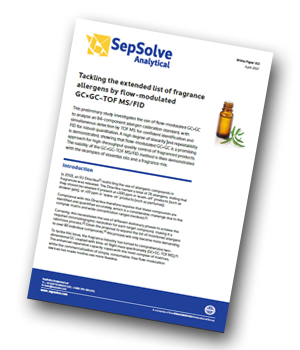SepSolve Analytical has produced a White Paper investigating the use of flow-modulated GC×GC to analyse an 84-component allergen calibration standard, with simultaneous detection by TOF MS for confident identification and FID for robust quantitation. A high degree of linearity and repeatability is demonstrated, showing that flow-modulated GC×GC is a promising approach for high-throughput quality control of fragranced products. The validity of the GC×GC–TOF MS/FID method is then demonstrated with the examples of essential oils and a fragrance mix.
 Introduction
Introduction
In order to comply with a 2003 EU Directive[1] restricting the use of allergenic compounds in fragrances, the fragrance industry has turned to comprehensive two-dimensional GC coupled with time-of-flight mass spectrometry (GC×GC–TOF MS) as a means of effectively monitoring allergens. This preliminary study evaluates the use of GC×GC with parallel detection by flame ionisation detection (FID) and TOF MS for an extended list of 84 allergens.
Results and Discussion
Covered topics are listed and full details can be found by downloading the White Paper using the link below:-
- Separation and identification of allergens
- Repeatability
- Validation of peak purity
- Linearity
- Analysis of real-world fragrance samples
- Detection limits
Conclusion
The method described enables robust quantitation and confident identification in a single run, making it an ideal system for R&D labs requiring full sample characterisation. Moreover, once method optimisation and validation is complete, the excellent repeatability of flow modulation allows the method to be easily translated across GC×GC–FID systems in multiple quality-control laboratories.
Reference
[1] Directive 2003/15/EC of the European Parliament and of the Council of 27 February 2003 amending Council Directive 76/768/EEC on the approximation of the laws of the Member States relating to cosmetic products.




